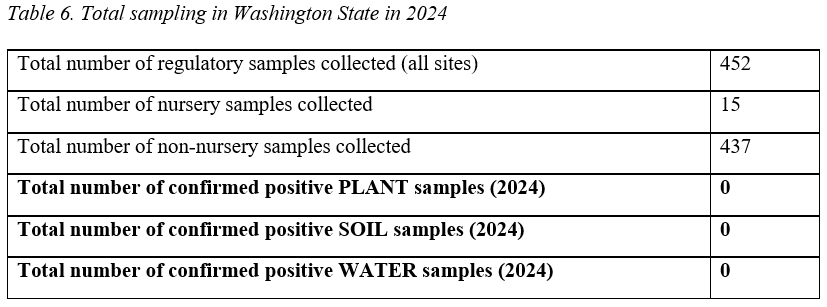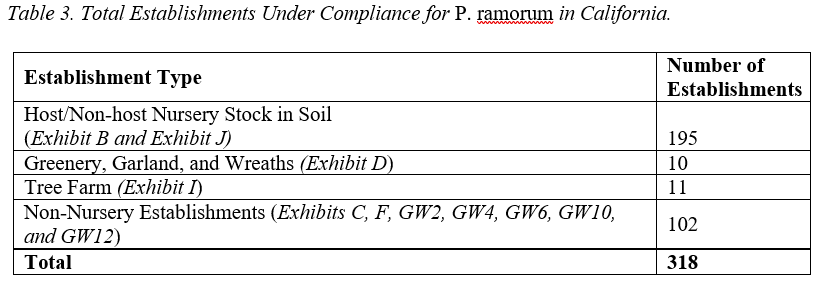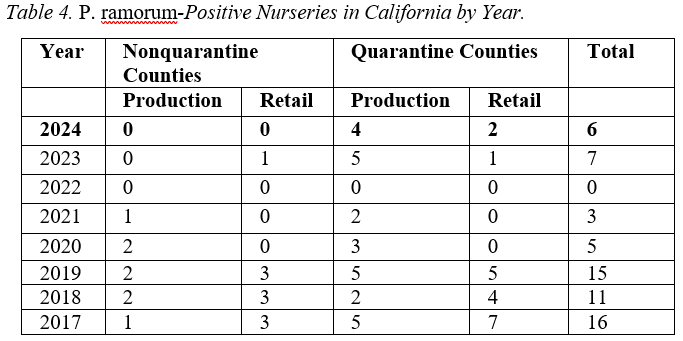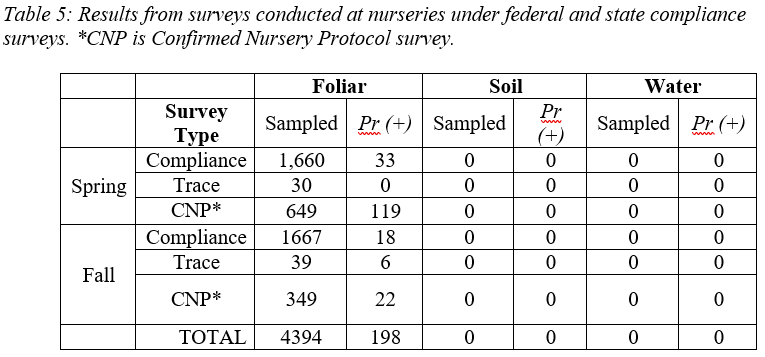Newsletter
The latest newsletter includes what’s happening with monitoring, funding, nurseries, education, the calendar of events, and more. Looking for something older? View the newsletter archive. Receive the newsletter directly in your inbox by signing up for our mailing list.
Current California Oak Mortality Task Force Newsletter: February 2025
(Printable COMTF Report February 2025)
Editor’s Note
In this issue, we summarize the status of Phytophthora ramorum in 2024 for Oregon forests, Eastern U.S. waterways, the United Kingdom, Nurseries and Landscapes.
Monitoring and Management in Oregon – 2024 Year in Review
In 2024, fifteen new P. ramorum infestations have been detected outside of the 2015 SOD Quarantine area. These new detections triggered an immediate expansion of the SOD Emergency Quarantine boundary, now approximately 148 square miles. (Fig 1). Using a 300-600 ft treatment buffer, 2024 eradication treatment areas totaled approximately 319 acres of private land, 156 acres of State Park lands, and 51 acres of U.S. Forest Service lands.

To monitor the spread of sudden oak death disease and detect new infestations, the Oregon SOD program uses various survey methods conducted throughout the year. These methods include aerial detection surveys enhanced by high-resolution digital imagery and ground verification, as well as ground-based transects and stream monitoring.
Oregon’s P. ramorum stream baiting program, aimed at efficiently sampling entire watersheds for P. ramorum, began in late April and ended in December 2024, during which 64 stream drainages inside and outside the quarantine area were monitored. Thirteen streams contained plant material that tested positive for P. ramorum. Ground surveys are planned for the new drainages along the north bank of the Rogue River and a stream that flows into the Elk River east of Port Orford. (Fig 2).

In July 2024, the U.S. Forest Service and the Oregon Department of Forestry cooperative aerial detection survey team conducted a fixed-wing survey, followed by a helicopter survey over forested lands in Curry County, to monitor the spread of disease and detect new infestations. These aerial surveys covered 787,500 acres of forested land. To complement the surveys, foresters from the Oregon SOD program began analyzing the high-resolution imagery from 2024 outside the Generally Infested Area (GIA) to identify declining or dead tanoak trees. The imagery project area now spans approximately 539,000 acres (842 square miles), covering the region between the California border and Coos County.
Ground surveys covered 860 acres, and 520 trees were sampled, of which 134 were positive for P. ramorum. SOD foresters conducted ground transect surveys covering 613 acres for the harvest of disease-free tanoak on private lands. Tanoak harvest is only allowed following the issuance of a special permit by the Oregon Department of Agriculture under OAR 603-052-1230, Oregon’s P. ramorum quarantine rules.
Progress for Oregon’s Slow-the-Spread Program in managing sudden oak death is updated monthly on the Oregon SOD Program Dashboard. Since the inception of the sudden oak death program, the Oregon Department of Agriculture (ODA) has monitored the expansion of the quarantine boundary to address the spread of P. ramorum across the landscape. Although multiple new infestations have occurred outside the current official quarantine area, these regions are still covered under the existing ODA SOD regulations, which enforce quarantine in any area statewide where a SOD infestation is identified (OAR 603-052-1230(2)(d). Given the 23 new detections outside the 2015 SOD quarantine boundary since 2021, SOD program representatives have proposed expanding the quarantine and GIA. The new proposed quarantine area encompasses 901 square miles, or 45% of Curry County, reflecting a 15% increase since 2015. The proposed GIA area covers 178 square miles (Fig. 3).

Resources: http://tinyurl.com/SOD-Program; http://tinyurl.com/SOD-Guide; http://tinyurl.com/odf-foresthealth.
Monitoring – Eastern U.S. Stream Survey
In 2024, 49 streams in nine eastern U.S. states (AL, FL, GA, IL, MD, MS, NC, SC, and TX) were surveyed in the USDA Forest Service, Cooperative Sudden Oak Death Early Detection Stream Survey (Table 1). Of 464 baited samples, PCR analysis detected Phytophthora ramorum from one stream in AL and one stream in SC. The positive stream in AL was associated with a nursery previously confirmed for sudden oak death while the source of inoculum in SC could not be determined after intensive sampling and survey of the residential watershed.
For the last five years (2020-2024), P. ramorum has been detected from seven streams in four states—four streams in AL, one stream in MS, one stream in NC, one stream in SC (Table 2). The pathogen has been consistently present in these streams for longer than ten years except the recent detection in SC.
Monitoring and Management in the United Kingdom – 2024 Year in Review
The following information was kindly provided to COMTF in late October 2024 by forest health professionals throughout the UK: Mick Biddle, Ben Jones, Barnaby Wylder, Joe McMinn, and Aoife Smith. The forest detection activities summarized here continued through the year, and so this information does not represent the totality of 2024 survey and management activity. Thanks to these colleagues for providing this helpful update.
Annual surveillance testing by Forest Research processed around 800 samples from around the UK in 2024. These tests originated from aerial (helicopter) observations of symptoms, followed by visits on the ground, and involved multiplex PCR assays to detect P. ramorum, P. pseudosyringae, and P. pluvialis. P. ramorum isolates were subjected to additional testing to determine genetic lineage.
In England, over 781,000 hectares of forest were surveyed aerially in 2024. This included nearly 36,000 hectares of Japanese larch surveyed for symptoms of P. ramorum infection. These detections were primarily in southwestern, northwestern, and northeastern England and were generally in the vicinity of previous detections. Follow-ups in 2024 indicated a trend of increasing detections of P. pseudosyringae, either on its own or together with P. ramorum, and most of these sites were located in northeastern and northwestern England.
In Wales, 172 sites were identified during two aerial survey flights for follow-up diagnostics and associated activities. As of late October, detections on eleven of these sites had resulted in mandatory tree felling notices. Similar to the situation in England, an increasing trend of P. pseudosyringae identifications was noted. Since no mandatory management activity (tree felling) is associated with these finds, it is possible that this trend will continue. One P. ramorum infection on sweet chestnut (Castanea sativa) was found in 2024.
In Scotland, positive detections in 2024, as of late October, trended downward compared to 2023: 472 symptomatic sites were identified for visits (compared to 617 in 2023), and of these 207 were determined positive (compared to 353 in 2023). The numbers of sites slated for visit as well as the number determined positive have trended slowly but steadily downward since 2020-2021. However, the total area required to be felled in response to P. ramorum infection, although also trending downward, has decreased much more slowly than the gross number of sites, with more than 1000 hectares of larch required to be removed each year. While P. ramorum detections have been scattered throughout Scotland, the most rapid development and concentrated spread of the disease since 2016 has been around the southwest. 2024 in general featured weather highly conducive to P. ramorum spread, and positive detections were made in rhododendron and also in several unusual hosts, including fir, monkey-puzzle, and eucalyptus. Given this, 2025 is anticipated to be an impactful year in terms of P. ramorum. Additionally, P. pseudosyringae was detected at five locations.
In Northern Ireland, 58 sites with symptomatic vegetation were identified by aerial survey, and 29 of those were identified as “highly probable” for infestation with P. ramorum. Generally, there was a trend of increasing P. ramorum detection in the west of the country. Watercourse detection was employed for the first time in Northern Ireland in 2024, with four sites turning up with positive watercourse baits. Since Northern Ireland follows EU rather than UK phytosanitary protocols, tree felling is not mandatory for EU isolates of P. ramorum, although follow-up action is required for non-EU isolates. Since its first detection in 2012, the predominant genetic lineage of P. ramorum in Northern Ireland has been EU2. In 2024, the most active area for P. ramorum spread has been in the northwest (County Tyrone), with P. ramorum confirmed on Larix kaempferi (Japanese larch), Larix X eurolepis (a hybrid of L. decidua and L. kaempferi), and Tsuga heterophylla (western hemlock), as well as confirmation of P. pseudosyringae infection of L. kaempferi.
Nurseries and Managed Landscapes – 2024 Year in Review
USDA APHIS, National Operations 2024 Summary. The following information summarizes information regarding the USDA APHIS Phytophthora ramorum program for the first ten months of 2024, as presented by Kristin Fox of USDA APHIS at the online COMTF meeting at the end of October. Thanks to Kristin for providing this information.
In 2024, nine nurseries shipping interstate and twelve nurseries shipping intrastate provided plant samples that were positive for P. ramorum. Of the interstate nurseries, four had positive detections in previous years, while of the intrastate nurseries, two had previous detections. Additionally, one residence was found with a P. ramorum-positive plant. Altogether this represented 22 detections, as compared with 31 in 2023. In 2023, the greatest number of positive samples (160 total positive detections) were Rhododendron samples, followed closely by Camellia and more distantly by Pieris; however, in 2024 the positive samples (426 positive detections) were overwhelmingly from two genera: Rhododendron and Loropetalum. Camellia accounted for only two positive detections in 2024. Whereas the Rhododendron samples in 2024 were divided almost evenly between those being shipped interstate and those being shipped intrastate, the Loropetalum samples were almost all interstate shipments.
Other updates from the USDA APHIS P. ramorum program in 2024 included new additions to the P. ramorum Domestic Regulatory Program Manual and the enactment of a new policy that the list of proven and associated hosts for P. ramorum will be updated yearly. Two new hosts were added to the proven host list: silverleaf cotoneaster (Cotoneaster pannosus) and evergreen dogwood (Cornus capitata). Finally, personnel changes in the USDA APHIS P. ramorum program included the retirement of Pat Shiel as National Science Program Coordinator, with his replacement by Lindsey Thiessen, and the retirement of National P. ramorum Operations Manager Betsy Randall-Schadel, who has been succeeded by acting program managers since her retirement.
California Department of Agriculture P. ramorum Nursery Program 2024 summary report. The California Department of Food and Agriculture (CDFA) receives funding from the United States Department of Agriculture (USDA) to administer the cooperative Phytophthora ramorum (P. ramorum) program. The CDFA assists and reimburses the county agricultural commissioners as they enforce Federal Domestic Quarantine 7 CFR 301.92 and California Code of Regulations 3700 regulations at the 318 establishments regulated for P. ramorum in California (see table below). Program funding allocated to the CDFA for the P. ramorum program is $1,132,843 for fiscal year 2024/2025.
Approximately 7,900 P. ramorum program regulatory samples were submitted to the CDFA Plant Pest Diagnostics Laboratory for processing in 2024. There were 162 samples that were determined to be positive for P. ramorum in 2024.
In 2024 one nursery that was previously positive and received enhanced biannual inspections completed the required six negative inspections necessary to be released from the enhanced inspection portion of the program. There are currently seven previously positive California nurseries receiving enhanced biannual inspections.
Oregon Department of Agriculture P. ramorum Nursery Program 2024 summary report. In 2024, the Oregon Department of Agriculture (ODA) Phytophthora ramorum Nursery Program worked with six interstate shippers under federal compliance agreements (7 CFR 301.92). These nurseries are in Washington (2), Marion (2), Columbia (1), and Clackamas Counties. The ODA also held compliance agreements with one intrastate shipper, which is regulated under Oregon state quarantine requirements (7 CFR 301.92 and OAR 603-052-1230). This nursery is in Clackamas County. Table 5 summarizes ODA’s results for the work described in this report.
Spring compliance surveys were completed by the end of April. The ODA tested 1,660 foliar samples for P. ramorum; of which 33 tested positive. The Confirmed Nursery Protocol delimitation work was conducted on the single nursery that tested positive. A total of 649 foliar samples were taken, of which 119 tested positive. The ODA did a trace inspection in June 2024 and found six positive P. ramorum foliar samples. This trace inspection resulted in a new addition to the program. 349 samples were taken during the CNP protocols resulting in 22 positive samples.
Fall compliance surveys were completed by end of November. In mid-November, 18 of the foliar samples collected from one nursery tested positive. No positive water was detected. The nursery has been undergoing the USDA Confirmed Nursery Protocol and as of this report one round of delimitation work has been completed and a second scheduled. In the first round, 33 positive foliar samples were identified. More than the required amount of plant material was destroyed, and fumigation work has begun at the nursery. Traceback information from the positive nursery led to the inspection to four additional nurseries in Clackamas County (3) and Washington county (1). Additionally, this fall, one nursery completed the required survey protocols and has exited the program.
Going into 2025, the ODA will continue implementing the CNP on the nursery where positive foliar samples were found. For more information, please contact Kevin Bailey at kevin.f.bailey@oda.oregon.gov.
Washington State Department of Agriculture (WSDA) P. ramorum 2024 summary report. In 2024, the Washington State Department of Agriculture (WSDA) processed over 450 plant, soil, and water samples collected within the state (Table 6). WSDA inspected nurseries that ‘opted-out’ of the Federal DA-2014-2 regulations and can no longer ship interstate. Host material appeared free of symptoms and no samples were collected, and WSDA confirmed none of the ‘opt-out’ nurseries are shipping interstate.
WSDA Plant Services staff conducted two Trace Forward investigations and collected symptomatic plant samples from out of state positive nurseries; all samples were negative. Staff also conducted a Trace Back investigation of a wholesale nursery which supplied plant material to an out-of-state nursery found positive in 2024. The plant material was shipped in 2021. No symptoms were found present on host plants in the Trace Back investigation. For more information contact Haley Palec at HPalec@agr.wa.gov.
Research
Cauldron NC, Press CM, Weisberg AJ, Horta Jung M, Corcobado T, Webber JF, Kageyama K, Hieno A, Masuya H, Uematsu S, Scanu B, Brasier CM, Jung T, Chang JH, Grünwald NJ. 2025. Intraspecific Variation and Recent Loss of Ancient, Conserved Effector Genes in the Sudden Oak Death Pathogen Phytophthora ramorum. Mol Plant Microbe Interact. 2025 Jan 27 (E-pub ahead of print). doi: 10.1094/MPMI-10-24-0131-R.
Abstract: Members of the Phytophthora genus are responsible for many important diseases in agricultural and natural ecosystems. Phytophthora ramorum causes devastating diseases of oak, and tanoak stands in US forests and larch in the UK. The four evolutionary lineages involved express different virulence phenotypes on plant hosts, and characterization of gene content is foundational to understanding the basis for these differences. Recent discovery of P. ramorum at its candidate center of origin in Asia provides a new opportunity for investigating the evolutionary history of the species. We assembled, high-quality genome sequences of six P. ramorum isolates representing three lineages from Asia and three causing epidemics in western US forests. The six genomes were assembled into 13 putative chromosomes. Analysis of structural variation revealed multiple chromosome fusion and fission events. Analysis of putative virulence genes revealed variations in effector gene composition among the sequenced lineages. We further characterized their evolutionary history and inferred a contraction of crinkler-encoding genes in the subclade of Phytophthora containing P. ramorum. There were losses of multiple families and a near complete loss of paralogs in the largest core crinkler family in the ancestor of P. ramorum and sister species P. lateralis. Secreted glycoside hydrolase enzymes showed a similar degree of variation in abundance among genomes of P. ramorum lineages as that observed among several Phytophthora species. We found plasticity among genomes from multiple lineages in a Phytophthora species and provide insights into the evolutionary history of a class of anciently conserved effector genes.
Related Research
EFSA PLH Panel (EFSA Panel on Plant Health), Civera, A.V., Baptista, P., Berlin, A., Chatzivassiliou, E., Cubero, J., Cunniffe, N., de la Peña, E., Desneux, N., Di Serio, F., Filipiak, A., Hasiów Jaroszewska, B., Jactel, H., Landa, B. B., Maistrello, L., Makowski, D., Milonas, P., Papadopulos, N. T., Potting, R., … Gonthier, P. 2025. Commodity risk assessment of Alnus cordata, Alnus glutinosa and Alnus incana plants from the UK. EFSA Journal 23:e9189. https://doi.org/10.2903/j.efsa.2024.9051
Abstract: The European Commission requested the EFSA Panel on Plant Health to prepare and deliver risk assessments for commodities listed in Commission Implementing Regulation (EU) 2018/2019 as ‘high-risk plants, plant products and other objects’. Taking into account the available scientific information, including the technical information provided by the applicant country, this Scientific Opinion covers the plant health risks posed by the following commodities: Alnus cordata, A. glutinosa and A. incana graftwood, bare-root plants and rooted plants in pots up to 7years old imported into the EU from the UK. A list of pests potentially associated with the commodities was compiled. The relevance of each pest was assessed based on evidence following defined criteria. Two EU-quarantine pests (Entoleuca mammata, Phytophthora ramorum (non-EU isolates)) and one non-quarantine pest (Phytophthora siskiyouensis) were selected for further evaluation. For the selected pests, the risk mitigation measures implemented in the UK and specified in the technical dossier were evaluated taking into account the factors reducing their efficacy. For these pests, an expert judgement is given on the likelihood of pest freedom taking into consideration the risk mitigation measures acting on the pest, including uncertainties associated with the assessment. The degree of pest freedom varies between the pests evaluated, with E. mammata being the pest most frequently expected on imported Alnus spp. small trees. Expert knowledge elicitation indicated, with 95% certainty, that between 9927 and 10,000 per 10,000 Alnus spp. small trees (bare-root plants or rooted plants in pots up to 7years old) would be free from E. mammata.
EFSA PLH Panel (EFSA Panel on Plant Health), Civera, A. V., Baptista, P., Berlin, A., Chatzivassiliou, E., Cubero, J., Cunniffe, N., de la Peña, E., Desneux, N., Di Serio, F., Filipiak, A., Hasiów-Jaroszewska, B., Jactel, H., Landa, B. B., Maistrello, L., Makowski, D., Milonas, P., Papadopulos, N. T., Potting, R., … Gonthier, P. 2024. Commodity risk assessment of Betula pendula and Betula pubescens plants from the UK. EFSA Journal, 22(11), e9051. https://doi.org/10.2903/j.efsa.2024.9051
Abstract: The European Commission requested the EFSA Panel on Plant Health to prepare and deliver risk assessments for commodities listed in Commission Implementing Regulation (EU) 2018/2019 as ‘High risk plants, plant products and other objects’. This Scientific Opinion covers plant health risks posed by plants of Betula pendula and B. pubescens imported from the United Kingdom (UK) taking into account the available scientific information, including the technical information provided by the UK. The commodities were grouped in the risk assessment as (a) bundles of 10–20 graftwood/budwood (up to 1-year-old), (b) bare root plants which include bundles of 25 or 50 seedlings or transplants (1–2years-old), bundles of 5, 10 or 15 whips (1–2years-old) and single bare root plants (1–7years-old), (c) plants in pots which include bundles of 5 and 10 cell-grown plants (1–2years-old) and rooted plants in pots (1–7years-old), and (d) large specimen trees up to 15-years-old. All pests associated with the commodities were evaluated against specific criteria for their relevance for this opinion. Two EU quarantine pests i.e. Meloidogyne fallax and Phytophthora ramorum (non-EU isolates) and two protected zone quarantine pests i.e. Entoleuca mammata and Thaumetopoea processionea fulfilled all relevant criteria and were selected for further evaluation. For the selected pests, the risk mitigation measures described in the technical dossier from the UK were evaluated considering the possible limiting factors. For these pests an expert judgement is given on the likelihood of pest freedom taking into consideration the risk mitigation measures acting on the pest, including uncertainties associated with the assessment. In the assessment of risk, the age of the plants was considered, as larger trees are more likely to be infested mainly due to longer time grown in the field. In addition, larger canopies and root systems are more difficult to inspect, thereby making the detection of pests more challenging on large trees. The likelihood of pest freedom varies among the pests evaluated, with M. fallax being the pest most frequently expected on the imported plants. The Expert Knowledge Elicitation (EKE) indicated with 95% certainty that between 9735 and 10,000 per 10,000 large specimen trees will be free from M. fallax.
Favaro, R., Berka, M., Pettersson, M., Thöming, G., Arce, C.C.M., Inácio, M.L., Turlings, T.C.J., Faria, J.M.S., Jung, T., Bazin, D., Pozzebon, A., Angeli, S., Cappellin, L. 2024. The use of volatile organic compounds in preventing and managing invasive plant pests and pathogens. Front. Hortic., Volume 3. https://doi.org/10.3389/fhort.2024.1379997
Abstract: Invasive pests and plant pathogens pose a significant threat to ecosystems and economies worldwide, prompting the need of anticipatory strategies. Preventing their introduction by detection at the ports of entry has been proven extremely difficult. This review explores the potential of biogenic volatile detection as a reliable preventive solution. It underscores the importance of early detection and rapid response as integral components of effective invasive pest management, and it discusses the limitations of current control measures and the increasing globalization that facilitates the spread of pests and pathogens. Through a synthesis of existing literature, this review analyzes the Volatile Organic Compound (VOC) emissions in five invasive model species: three insects, Halyomorpha halys, Spodoptera frugiperda, Helicoverpa armigera, a nematode, Bursaphelenchus xylophilus, and an oomycete, Phytophthora ramorum. The review focuses on the specific volatiles, released by both the invasive organisms and the infested host plants. If available, the volatiles emitted from similar species were considered for comparison. Ultimately, this review highlights specific pest volatile and shared Herbivore Induced Plant Volatiles (HIPVs) as a reliable and innovative solution in pest detection. If possible, candidate compounds are provided, whilst the lack of some emphasizes the urge of expanding the information available.
Green, S., Cooke, D.E.L., Barwell, L., Purse, B.V., Cock, P., Frederickson-Matika, D. et al. 2024. The prevalence of Phytophthora in British plant nurseries; high-risk hosts and substrates and opportunities to implement best practice. Plant Pathology, 00, 1–22. https://doi.org/10.1111/ppa.14044
Abstract: Invasive Phytophthora species infect a very broad range of herbaceous and woody hosts globally. The UK alone has experienced a particularly damaging series of outbreaks and epidemics of new, invasive Phytophthora species affecting the nation’s trees over the last 30 years. The link between Phytophthora outbreaks and the importation and spread of infected nursery stock is well established across many countries worldwide. To understand better the pathways of spread of Phytophthora in the nursery trade in Britain, we applied a standardized nursery sampling method combined with a refined metabarcoding detection method to capture the diversity of Phytophthora species at 134 British plant nurseries representing a range of biosecurity and trading practices over multiple sampling years between 2016 and 2022. This included root and water samples collected from 17 nurseries sampled seasonally and root samples collected from 117 nurseries sampled once as part of plant health inspections. Based on analyses of 1894 pooled samples, DNA barcodes of 85 Phytophthora species or complexes were detected, with variation in species’ relative frequencies across nurseries. We present the top 20 host–Phytophthora associations ranked by relative frequency and report five novel Phytophthora records for the UK. We identified surprisingly high-risk hosts (such as Douglas fir) with the greatest number of Phytophthora associations and revealed Phytophthora nursery niche preferences for water or roots. We discuss the implications of our findings in terms of pathogen diversity and abundance, high-risk hosts, our information dissemination approach and resulting advice on nursery practices aimed at reducing risk.








